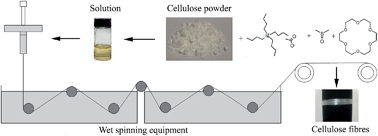Quaternary ammonium acetate: an efficient ionic liquid for the dissolution and regeneration of cellulose†
Abstract
Cellulose (8%) can be dissolved in tetrabutylammonium acetate (TBAA) with dimethyl sulfoxide (DMSO) and crown ether (18-crown-6) within 5 min at 40 °C without any pretreatment.


 Please wait while we load your content...
Please wait while we load your content...